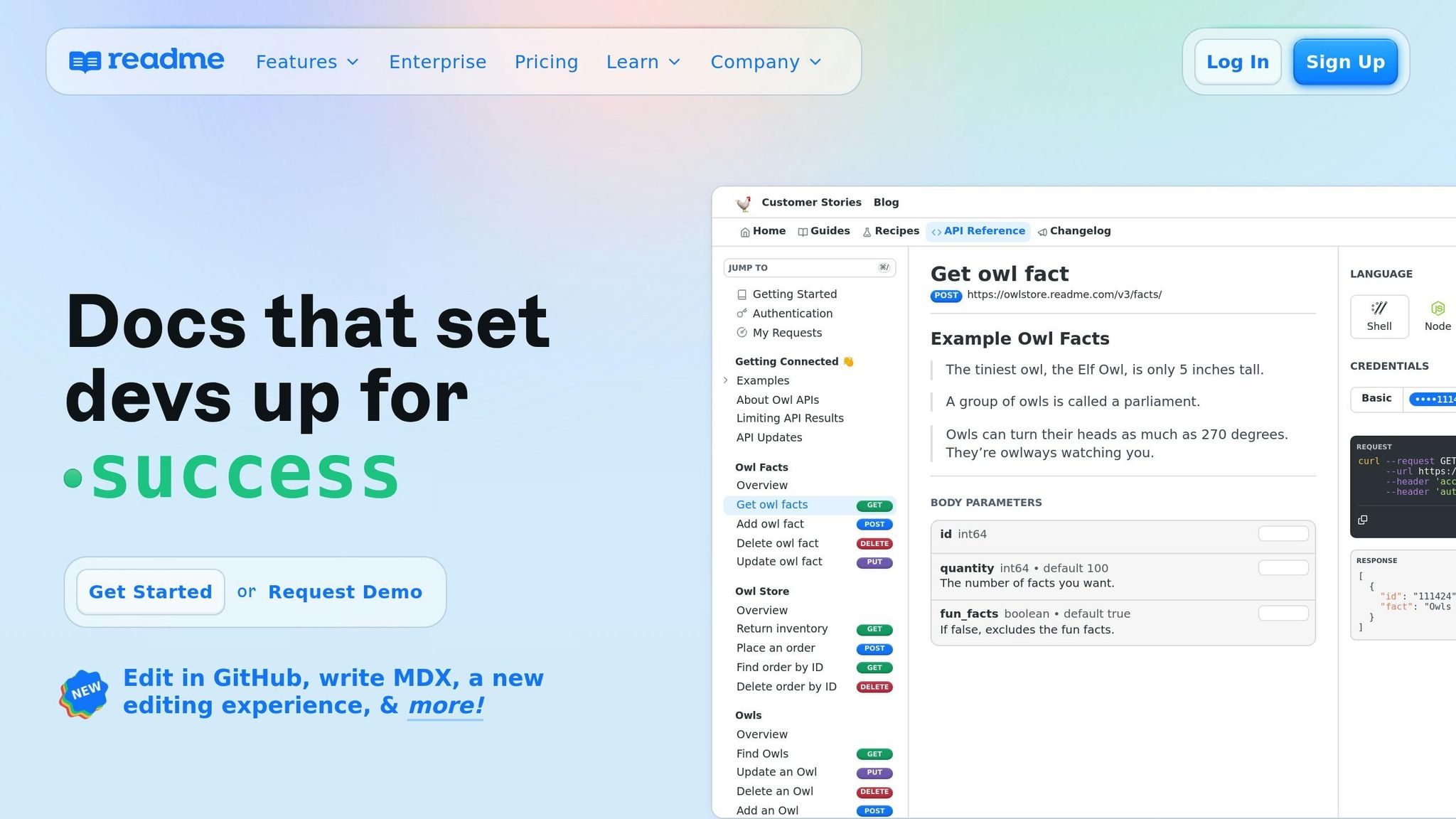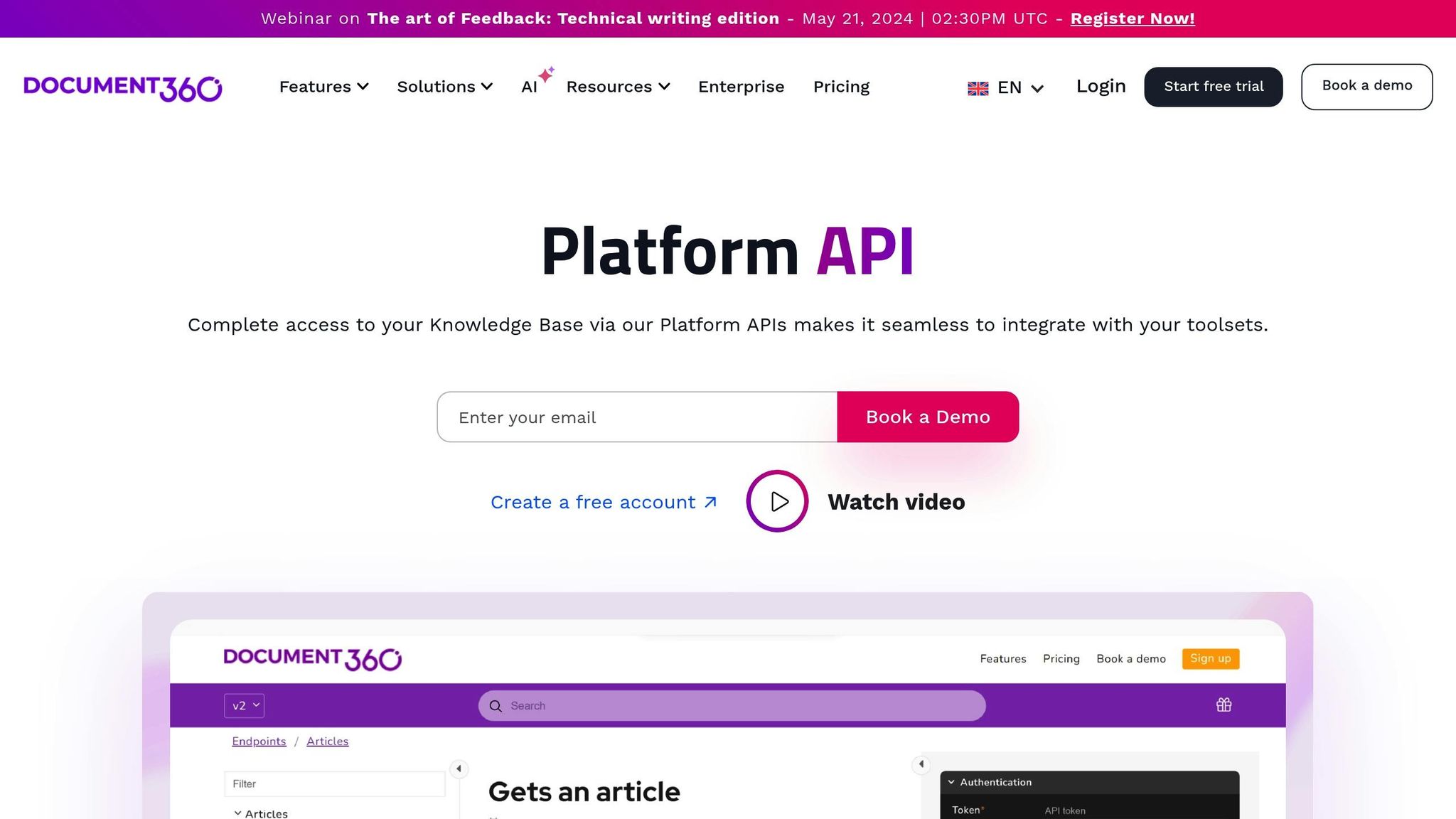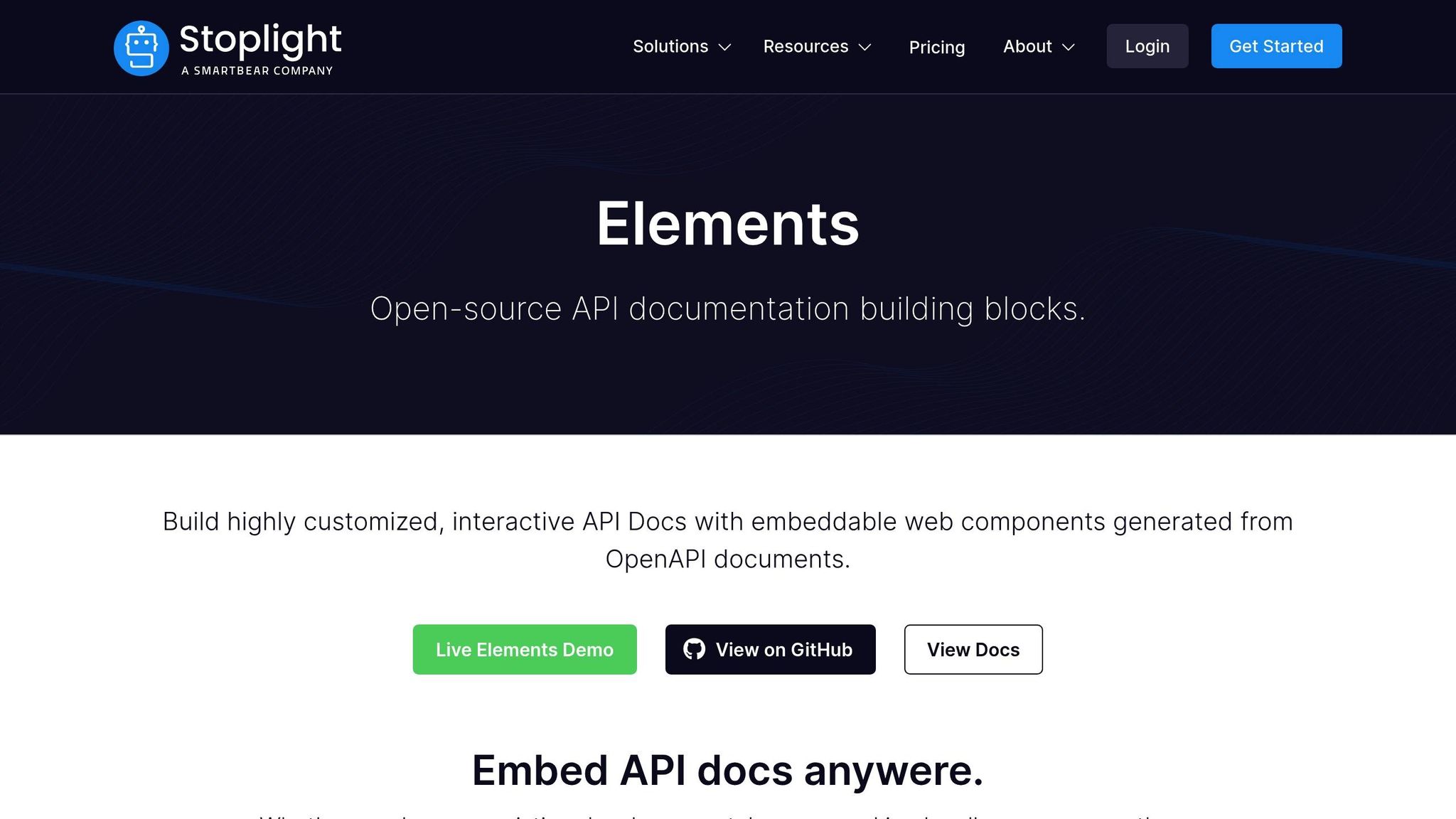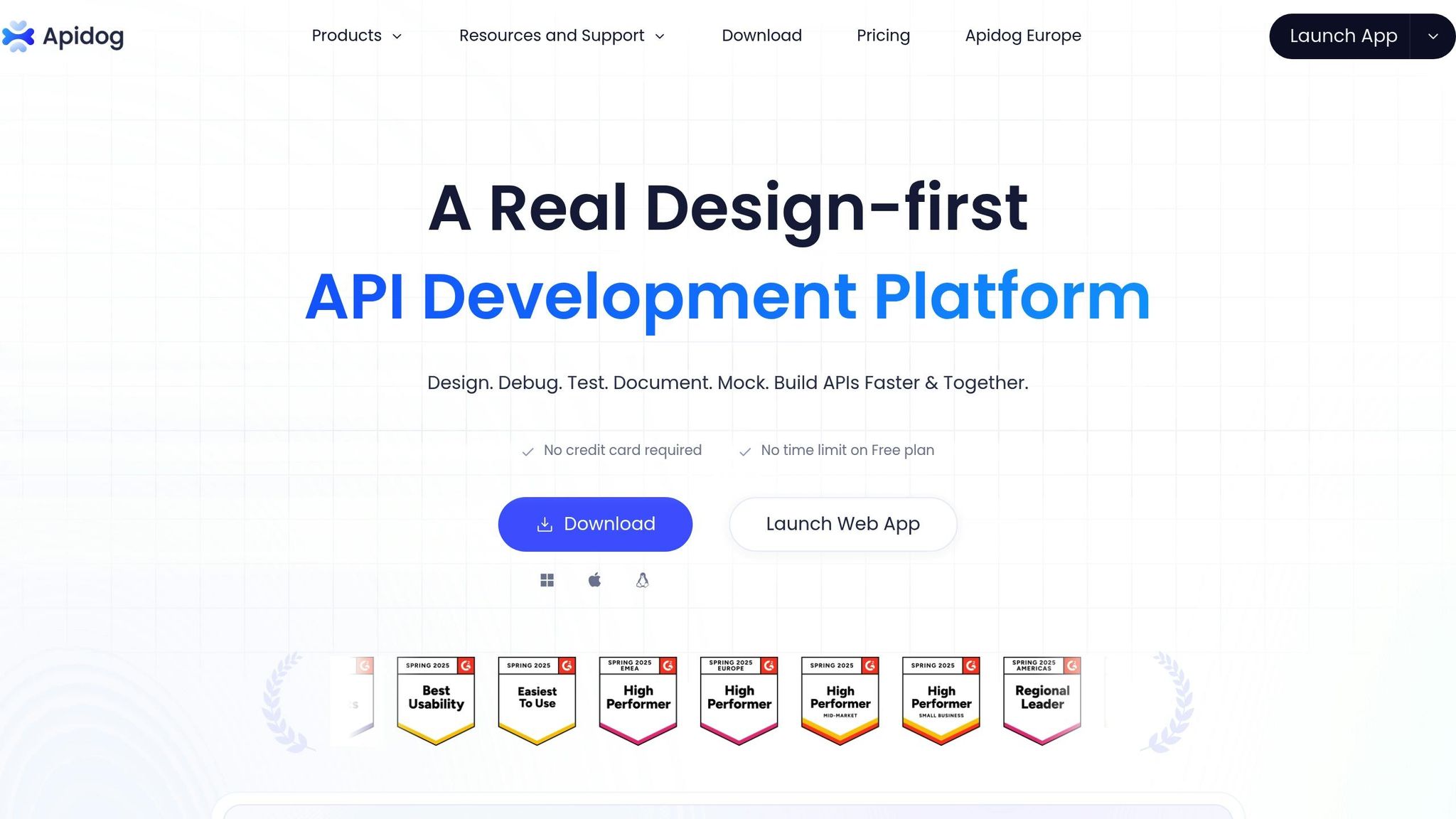Developers spend up to 50% of their time on rework due to unclear API documentation. Interactive API documentation tools solve this by enabling real-time testing, live code generation, and collaboration. These tools streamline workflows, improve productivity by 20–30%, and cater to both beginners and experts.
Here are the top 5 interactive API documentation tools you should know:
- Swagger UI: Test endpoints directly in your browser with OpenAPI integration and customizable UI.
- Document360: Supports multiple OpenAPI versions, live testing, and team collaboration tools like version control.
- ReadMe: Features an API Explorer, sandbox testing, and GitHub integration for seamless updates.
- Stoplight Elements: Offers mock servers, OpenAPI support, and design-first documentation tools.
- Apidog: Combines automated documentation, advanced testing, and real-time editing for teams.
Quick Comparison
| Feature | Swagger UI | Document360 | ReadMe | Stoplight Elements | Apidog |
|---|---|---|---|---|---|
| OpenAPI Support | Yes (2.0/3.0) | Yes (2.0/3.1) | Yes (3.0/3.1) | Yes (3.0/3.1) | Yes (2.0/3.0/3.1) |
| Testing Tools | Basic requests | Live testing | Sandbox testing | Mock servers | Advanced suite |
| Customization | High | Full branding | Custom themes | CMS integration | Visual interface |
| Collaboration | Basic tools | Role-based access | GitHub sync | Git integration | Real-time editing |
| Best For | Testing basics | Teams with docs | Branded docs | Design-first APIs | End-to-end APIs |
Choose the right tool by assessing your API’s complexity, team size, and need for scalability. These tools simplify API workflows, improve documentation quality, and save time.
Document and design API documentation using Readme.io and Postman

1. Swagger UI

Swagger UI transforms API documentation into an interactive experience, enabling developers to test endpoints directly from their browser.
OpenAPI Integration
With Swagger UI, you can generate dynamic, interactive documentation straight from OpenAPI Specification files. The built-in Swagger Editor also validates your documentation and offers suggestions for improvements [3].
Hands-On Testing
The “Try it out” feature is a game-changer for developers. It lets you:
- Run API requests directly in the browser
- Experiment with HTTP methods like GET, POST, PUT, and DELETE
- Instantly view request responses
- Test authentication methods such as OAuth2 or API keys [4]
Customization Features
Swagger UI offers plenty of design flexibility, allowing you to tailor the interface to fit your brand. You can tweak:
- CSS for styling
- HTML templates
- JavaScript for added functionality
- Themes and layouts [5]
Plus, the documentation is fully responsive, ensuring a smooth experience on both desktop and mobile devices [3].
Collaboration Made Easy
Swagger UI enhances team efficiency by supporting:
- Real-time API testing
- Consistent documentation across environments
- Early identification of potential errors
- Automatic updates to documentation when APIs change
It also integrates seamlessly with tools like WSO2 API Manager [3], simplifying workflows and keeping everything organized.
This streamlined approach makes Swagger UI a standout choice for interactive API documentation.
2. Document360

Building on tools like Swagger UI, Document360 empowers users to create interactive API documentation with support for multiple OpenAPI versions and live testing capabilities.
OpenAPI Support
Document360 supports OpenAPI 2.0, 3.0, and 3.1, streamlining the process of creating API documentation [6]. It allows users to import specifications through:
- JSON or YAML file uploads
- Direct URL imports
- Postman API specifications
Once imported, the platform automatically generates detailed documentation for API endpoints, methods, and responses. This automation can save significant time – industry research shows it may cut documentation efforts by up to 50%, helping teams bring new products and features to market faster [8].
This robust OpenAPI support also sets the stage for real-time endpoint validation, ensuring accuracy and reliability.
Testing Features
The platform includes a “Try-it” console, enabling real-time API testing directly within the documentation [7]. Document360’s testing framework is divided into three key phases:
| Testing Phase | Purpose | Key Benefits |
|---|---|---|
| Functional | Validates API features based on specifications | Ensures correct input/output behavior |
| Performance | Assesses the API’s ability to handle high traffic | Confirms scalability and reliability |
| Acceptance | Verifies the API solves the intended business problem | Adapts to evolving needs |
This integrated testing functionality ensures APIs are not only functional but also scalable and aligned with business goals.
Design Options
Document360 simplifies the creation of code samples by automatically generating examples in various programming languages [8]. Users can define objects with 'type': 'object' and enable features like 'isForDisplay': true to render code snippets. Activating the “Try it” feature is as simple as confirming the server URL [6].
Team Collaboration
Collaboration is a core strength of Document360, offering tools to keep teams in sync:
- Private notes and discussion threads
- Version control with detailed history tracking
- Role-based access controls for secure collaboration
- Integrations with Slack and Microsoft Teams for real-time updates
“Document360 allowed us to bring our API documentation fully in line with industry standards, both meeting and exceeding our users’ expectations.” – Dave Ingram, Senior Technical Writer, Mindful [8]
This comprehensive tool addresses a significant challenge in the industry: 62% of developers report that limited time is their biggest obstacle to maintaining up-to-date API documentation [8]. Document360’s features make it easier for teams to overcome this hurdle and produce professional, reliable documentation.
3. ReadMe
ReadMe is a trusted platform used by over 6,000 teams to create interactive API documentation [10]. Let’s break down what makes ReadMe stand out, from its robust OpenAPI support to its testing, design, and collaboration features.
OpenAPI Support
ReadMe supports OpenAPI v3.0.x/v3.1, Swagger v2.0, and Postman Collections (converted using postman-to-openapi). It auto-generates interactive API references while preserving additional Markdown content – unless the operationId changes [9].
Testing Features
ReadMe simplifies API testing with intuitive tools designed for seamless validation and setup. Here’s a closer look:
| Feature | Purpose | Benefit |
|---|---|---|
| API Explorer | Test live endpoints | Validate functionality instantly |
| Default Values | Pre-filled request data | Speeds up testing setup |
| Raw JSON Editor | Edit request bodies directly (Enterprise) | Full control over body editing |
| Sandbox Environment | Safe testing environment | Experiment without risks |
In addition to testing, ReadMe provides extensive design customization to reflect your brand.
Design Options
ReadMe offers flexible design features to create visually engaging and branded documentation, including:
- Custom login pages for personalized user experiences
- Integration with JSX and Tailwind for interactive and branded components
- Dynamic hub design with customizable navigation options [12]
Team Collaboration
ReadMe also makes team collaboration smoother and more efficient, thanks to these standout features:
- GitHub Integration: The CLI tool syncs OpenAPI files directly from GitHub for seamless updates [10].
- Version Control: Tracks changes effectively, ensuring teams stay aligned.
- Real-time Updates: With 85% of customers generating API references directly from API description files [11], ReadMe ensures documentation stays in sync with the API’s current implementation.
4. Stoplight Elements

Stoplight Elements stands out as a tool for interactive API documentation, offering strong OpenAPI support and built-in testing capabilities to enhance the development process.
OpenAPI Support
Stoplight Elements takes your OpenAPI documents and turns them into interactive, user-friendly documentation [2]. It works with OpenAPI and JSON Schema to create dynamic, reusable content and supports both OpenAPI 3.0 and 3.1 specifications [13]. Companies like Spotify and Authmoji rely on Elements for documenting their APIs [2].
Testing Features
To ensure APIs function as intended, Elements includes several useful testing tools:
| Testing Feature | Description | Benefit |
|---|---|---|
| Request Maker | Test API endpoints directly | Hands-on API interaction |
| Mock Servers | Create servers with Prism | Enables parallel development |
| Validation Tools | Check compliance with OpenAPI specs | Ensures API consistency |
| Multiple Servers | Support for various environments | Simplifies cross-environment testing |
“Ensuring excellent DevEx requires you to rigorously test your APIs to ensure they perform as expected” [14].
Design Options
Elements also provides a range of design features to customize and enhance API documentation:
- CMS Integration: Easily embed documentation into existing content management systems [2].
- Schema and Formatting: Use JSON Schema and advanced Markdown to create structured, templated documents [2].
- Visual Preview: Preview documentation directly through Stoplight Studio for better editing and review [15].
Team Collaboration
Collaboration is a key focus of Stoplight Elements, offering tools that help teams work efficiently:
- Git Integration: Track changes with version control [17].
- Central Source: Maintain a single, reliable source for all API documentation [16].
- Comment Tracking: Facilitate discussions and feedback within the Stoplight Editor [16].
- Inclusive Platform: Designed to support both technical and non-technical team members [16].
5. Apidog

Apidog combines documentation, testing, and collaboration into one streamlined platform, offering a comprehensive solution for API workflows.
OpenAPI Support
Apidog provides extensive support for the OpenAPI Specification (OAS), making it a versatile tool for API development. Here’s what it can do:
- Full Compatibility: Import OpenAPI (Swagger) specifications in both JSON and YAML formats [19].
- Multi-Language Support: Generate request samples in over 20 programming languages [18].
- Automated Documentation: Create interactive API documentation directly from OpenAPI schemas [20].
- Schema Extensions: Support OpenAPI/Swagger extensions to expand functionality [19].
Testing Features
Apidog’s testing suite simplifies the process of verifying API functionality with a range of helpful tools:
| Feature | Capability | Benefit |
|---|---|---|
| Automated Request Generation | Generate requests based on API specs | Saves time and reduces errors |
| Visual Assertion Testing | Define conditions using a GUI | Makes testing accessible without coding |
| Database Integration | Perform CRUD operations directly | Enables complete end-to-end testing |
| Environment Management | Configure multiple environments | Simplifies testing across setups |
These features make testing efficient and reduce the chances of errors in the API lifecycle.
Design Options
Apidog provides tools to create visually appealing and functional API designs:
- Visual Interface: Use intuitive tools to design API documentation effortlessly [18].
- Custom Styling: Adjust navigation, layout, and branding elements to fit your needs [18].
- Unified Documentation: Seamlessly integrate API specifications with Markdown-based documentation [18].
Team Collaboration
Collaboration is at the heart of Apidog, with features that ensure teams can work together effectively:
- Real-Time Editing: Enable multiple users to edit HTTP APIs and data models simultaneously [22].
- Smart Sharing: Share collaboration links with embedded parameter values for quick endpoint access [22].
- Access Control: Assign project-specific permissions for external collaborators [21].
- Change Tracking: Maintain a comprehensive history of API changes for easy recovery [21].
Apidog’s detailed collaboration tools, including field-level editing and conflict resolution, make it a great choice for managing complex API projects with a team.
Features at a Glance
Here’s a quick breakdown of the key features offered by five leading interactive API documentation tools:
| Feature Category | Swagger UI | Document360 | ReadMe | Stoplight Elements | Apidog |
|---|---|---|---|---|---|
| OpenAPI Support | OAS 2.0/3.0 with full compatibility | Auto-generates from API definition files | Native OpenAPI support | Supports multiple protocols, including OpenAPI | Full OAS compatibility |
| Customization | Highly customizable UI themes | Fully customizable branding and themes | Custom themes and branding options | Visual design tools | Customizable UI options |
| Code Samples | Supports multiple languages | Auto-generated samples | Interactive examples | Multi-language support | Provides samples in various programming languages |
| Testing Tools | Basic request testing | API explorer | Interactive API testing | Built-in mock server | Advanced testing suite with GUI |
| Team Features | Basic collaboration tools | Role-based access control | Real-time collaboration | Git integration for version control | Real-time editing and smart sharing options |
| G2 Rating | 4.5/5.0 [1] | Not available | 4.5/5.0 [24] | 4.4/5.0 [1] | 4.9/5.0 [24] |
| Standout Feature | Industry-standard reference | Comprehensive documentation solution | Usage metrics integration | Design-first approach | Advanced testing tools |
This table highlights the critical features of each tool, giving you a clear comparison to guide your decision-making.
Key Integration Capabilities
Each of these tools excels in unique integration capabilities, enhancing productivity and usability:
- Swagger UI: Extensive support for third-party integrations ensures flexibility.
- Document360: Streamlines workflows by centralizing documentation tasks.
- ReadMe: Includes Slack integration for real-time notifications and updates.
- Stoplight Elements: Enforces style guide standardization for consistent documentation.
- Apidog: Covers end-to-end testing workflows for seamless API management.
These integrations add significant value, making each tool more effective in its own way.
Performance Considerations
According to SmartBear’s State of API 2020 Report, “Accurate and Detailed documentation” ranks as the third most critical API characteristic [23]. This underscores the importance of selecting a tool that meets your documentation needs effectively. Next, we’ll explore how to apply these insights in practice.
Next Steps
Choosing the right API documentation tool means taking a close look at your team’s needs and the technical demands of your project.
Evaluate Technical Requirements
Start by assessing how complex your API is and what kind of documentation it needs. Research shows that nearly 70% of technical teams struggle with unclear instructions, which can slow down progress [26]. Look for tools that support your API’s protocol – whether it’s REST, GraphQL, or another standard – and ensure they align with your development workflow.
Consider Team Size and Expertise
The size and skill level of your team should guide your decision. Teams equipped with effective tools tend to finish projects 30% faster [26]. For smaller teams, focus on tools that offer:
- Easy-to-use interfaces
- Pre-built templates
- Automated documentation features
- Simple version control systems
Plan for Scalability
“Much like a great UI is designed for optimal user experience, a great API is designed for optimal consumer experience.” [25]
Scalability is key for future growth. Choose tools that address:
| Scalability Factor | What to Look For |
|---|---|
| Traffic Handling | Autoscaling for sudden usage spikes |
| Integration Options | Support for various authentication methods |
| Version Management | Clear workflows for versioning and deprecation |
| Performance Monitoring | Built-in analytics and tracking tools |
Security and Maintenance
Security is non-negotiable. As David Berlind, editor-in-chief of ProgrammableWeb, points out:
“Attacks are becoming sophisticated, multi-dimensional, and hyper-targeted.” [25]
Look for tools that provide:
- Regular security updates
- Access control and permissions management
- Audit logs for tracking changes
- Automated backup systems
Monitor and Optimize
Interactive documentation can cut support inquiries by as much as 30% [26]. To fine-tune your documentation, monitor these key metrics:
- How often the documentation is accessed
- Levels of user engagement
- Common errors and recurring issues
- Developer feedback and satisfaction
Use these insights to keep improving your API documentation strategy.
FAQs
×
How do interactive API documentation tools help developers work more efficiently?
Interactive API documentation tools make the development process smoother by allowing developers to test APIs in real-time while following clear, step-by-step instructions. These tools let users send requests and see responses instantly, cutting down on troubleshooting time and simplifying the integration process.
They’re also a game-changer for onboarding. By offering a hands-on experience, new developers can quickly learn how to use APIs without feeling overwhelmed. Well-organized, interactive documentation reduces the need for external support, enabling teams to focus on creating solutions more efficiently.×
What should my team look for when selecting a tool for interactive API documentation?
When choosing an interactive API documentation tool, a few important factors should guide your decision. Ease of use tops the list – the tool needs to be simple enough for both tech-savvy developers and non-technical team members to navigate without frustration. Features like interactive code examples, markdown compatibility, and built-in collaboration tools can make a big difference in streamlining your workflow.
It’s also essential to think about how the tool fits into your current systems and processes. A seamless integration ensures minimal disruption and keeps things running smoothly. Customization is another key consideration – this lets you tailor the documentation to reflect your brand and better connect with your audience. And, of course, the pricing structure should align with your budget while still delivering the features your team requires.
Finally, don’t overlook support. A tool backed by responsive customer service and an engaged user community can be a lifesaver when you need help or additional resources.×
Can these tools work with my current development workflow and platforms?
Many of the leading tools for creating interactive API documentation are built to fit seamlessly into your existing development workflows. Take Postman, for instance – it integrates with CI/CD tools like Jenkins and GitHub, allowing teams to automate both testing and documentation tasks. On the other hand, SwaggerHub provides strong collaboration and version control features, making it simple to keep your API documentation in sync with your development process.
These integrations not only simplify workflows but also enhance team collaboration and maintain consistency throughout your API development efforts.

Leave a Reply